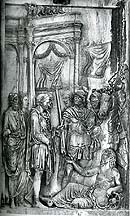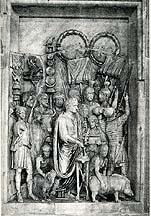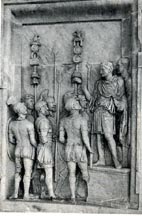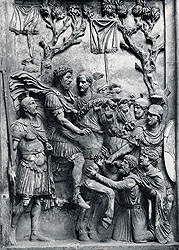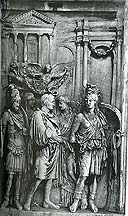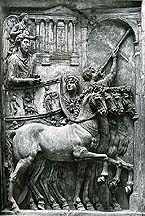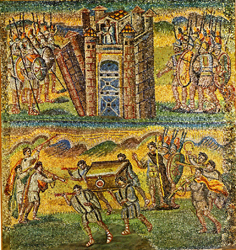Art Home | ARTH Courses | ARTH 209 Assignments | ARTH 200 Assignments
Panel Reliefs of Marcus Aurelius and Roman Imperial Iconography
Roman art developed a very coherent language for representing Imperial authority. The formulas articulated the roles of the Emperor in Roman society, as military leader (imperator) , priest (pontifex maximus), lawgiver, source of charity, etc. Romans would read into these formulas the virtues of a good emperor: strong, just, pious, liberal, and benevolent. By employing these conventions the Emperor could trust that the meanings would be clear to a Roman audience, and the Emperor could also draw his likeness to the great emperors of the past. The formulas of Roman Imperial iconography appear in individual, free-standing statues, on relief sculptures like those associated with Triumphal Arches or Columns, in paintings, and on Roman coins.
From the reign of the Emperor Marcus Aurelius comes a series of panels which well illustrate many of the the conventions of Roman Imperial iconography. The panels probably commemorate the Emperor's victories over the Sarmatian and German tribes and the triumph of 176 AD. Of the eleven extant panels, eight were later incorporated into the attic of the Arch of Constantine at the beginning of the fourth century, while the remaining three are now embedded in the walls of the Museo del Palazzo dei Conservatori. The heads of the Emperor in the panels incorporated into the Arch of Constantine were recarved to present the likeness of Constantine. These were later changed in the eighteenth century to the likeness of Trajan, while the Conservatori panels still bear the likeness of Marcus Aurelius. There is no certainty about the original use of these panels. They possibly were included in one or possibly two arches dedicated to Marcus Aurelius.
| Profectio: the profectio is a convention in Roman Imperial art showing the figure of an emperor or general setting out. The Aurelian panel probably refers to Marcus Aurelius's departure in 169 AD for a northern campaign. The bearded figure with toga standing behind him can be identified as Genius Senatus. Remember in the Roman formula of power: SPQR (Senatus Populusque Romanorum) , the Emperor receives his power from the Senate and the People of Rome. The reclining female figure has been identified as a personification of the Via Flaminia, one of the major Roman roads, which played a central role in establishing and maintaining the Roman Empire. | |
| Lustratio: at the outset of a military campaign, the army would carry out a purification ritual. Here Marcus Aurelius performs the ceremony at a portable altar. This scene would also illustrate the emperor's pietas, or dutiful maintenance of customary ritual acts for the gods. | |
| adlocutio:
the adlocutio is one of the most widely represented formulas
of Roman art. The convention is regularly shown in individual figures
|
|
| Justitia: Roman Emperors were the source of the law and justice. Here we see Marcus Aurelius seated on a podium. His hand gesture articulates his judgment, while a barbarian being supported pleads his case below. The belted tunic with leggings as well as he long beard identify this figure as a barbarian. The scene echoes a frequent theme in Roman Imperial art of bringing justice and civilization to the barbarians. In images of justitia or the traditio legis (the emperor handing down the law), the emperor or judge is regularly seated. The seat which would be become in the Christian tradition the cathedra, or the seat of the bishop, carries with it the connotations of authority, the "seat of justice." It was known in ancient Rome as the sella curulis. | |
| Conquest
and Clemency:
dressed in a cuirass Marcus Aurelius appears on horseback. This clearly
echoes the individual figure formula of the |
|
|
|
|
| Adventus: the adventus formula is another widely popular formula of Roman Imperial art that would come to play an important role in Christian art with images like the Entry of Christ into Jerusalem. The adventus formula presents the formal arrival of the Emperor into a city. It conveys the significance of the presence of the Emperor in the city. The Aurelian panel represents the adventus that took place in 176 AD when Marcus Aurelius returned to Rome from his northern campaign. The appearance of the same arch in this relief that appeared in the profectio scene identifies the city as Rome. The allegorical nature of this scene is marked by the presence of gods and personifications as companions of Marcus Aurelius. To the left stands the bearded Mars dressed in cuirass as the God of war, while to the right stands the personification of Roma, wearing a helmet and holding a shield. Above the head of Marcus Aurelius is a nike, or winged victory, bearing garlands. | |
| Liberalitas: Emperors saw themselves as providers for the needs of the Roman citizens. In building markets, aqueducts, road systems, amphitheaters, etc. the Emperors were meeting these needs. Acts of charity showed the interests of the Emperors in the welfare of the people of Rome. The Emperor is shown seated on a sella curulis, or the seat of the magistrate, and thus the seat of civil authority. It has been argued that the figure of Commodus, the son of Marcus Aurelius, was originally included alson seated on a sella curulis, to the left of Marcus Aurelius. This would refer to the joint act of liberalitas that the two granted in 177 in celebration of their victory in 176. The figure of Commodus probably also accompanied his father in the triumphal chariot representing the triumph after the 176 victory. It is likely that both figures of Commodus were eliminated from these reliefs after his damnatio memoriae. | |
Triumph: Marcus Aurelius, being crowned by a Nike figure, is shown riding in a four horse chariot. The chariot is decorated with reliefs showing the figures of Neptune and Minerva flanking the figure of Roma. A temple appears behind.  Like the triumphal procession from the Arch of Titus, an arch appears on the right side of the relief. The illusion is created of the chariot passing through the arch marking the entrance into the city of Rome. It is this moment of entering into the city that marks beginning of a triumphal procession. As noted above, the figure of Commodus in all probabilty accompanied Marcus Aurelius in the chariot. This is suggested by the large size of the chariot which appears designed to carry a second figure, and the gesture of the figure of Victory above who appears to be holding crowns for two figures. Commodus was eliminated after his death in disgrace. Following the Roman practice of damnatio memoriae, his public images were systematically expunged. Commodus was the Emperor and nemesis in the movie The Gladiator. Like the triumphal procession from the Arch of Titus, an arch appears on the right side of the relief. The illusion is created of the chariot passing through the arch marking the entrance into the city of Rome. It is this moment of entering into the city that marks beginning of a triumphal procession. As noted above, the figure of Commodus in all probabilty accompanied Marcus Aurelius in the chariot. This is suggested by the large size of the chariot which appears designed to carry a second figure, and the gesture of the figure of Victory above who appears to be holding crowns for two figures. Commodus was eliminated after his death in disgrace. Following the Roman practice of damnatio memoriae, his public images were systematically expunged. Commodus was the Emperor and nemesis in the movie The Gladiator. |
|
| Sacrifice:
one
of the traditional roles of a Roman Emperor was to be the pontifex
maximus or chief priest. |
